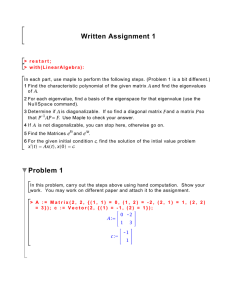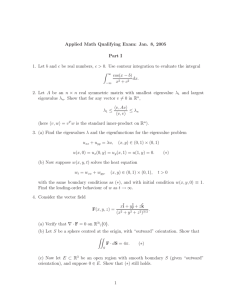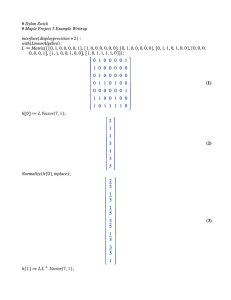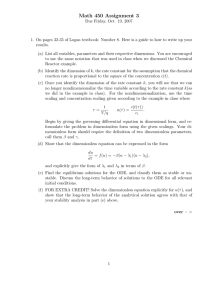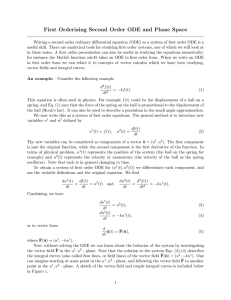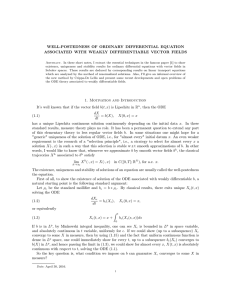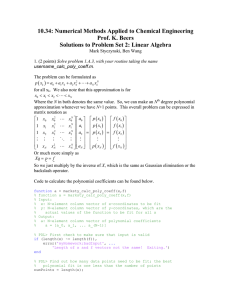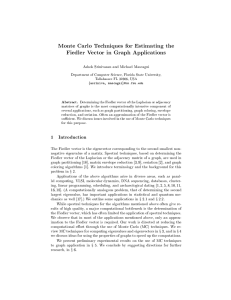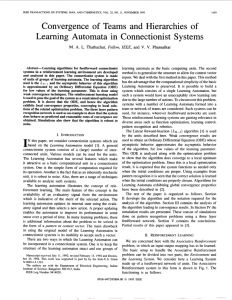Applied Mathematics Qualifying Exam September 3, 2005 Part I
advertisement
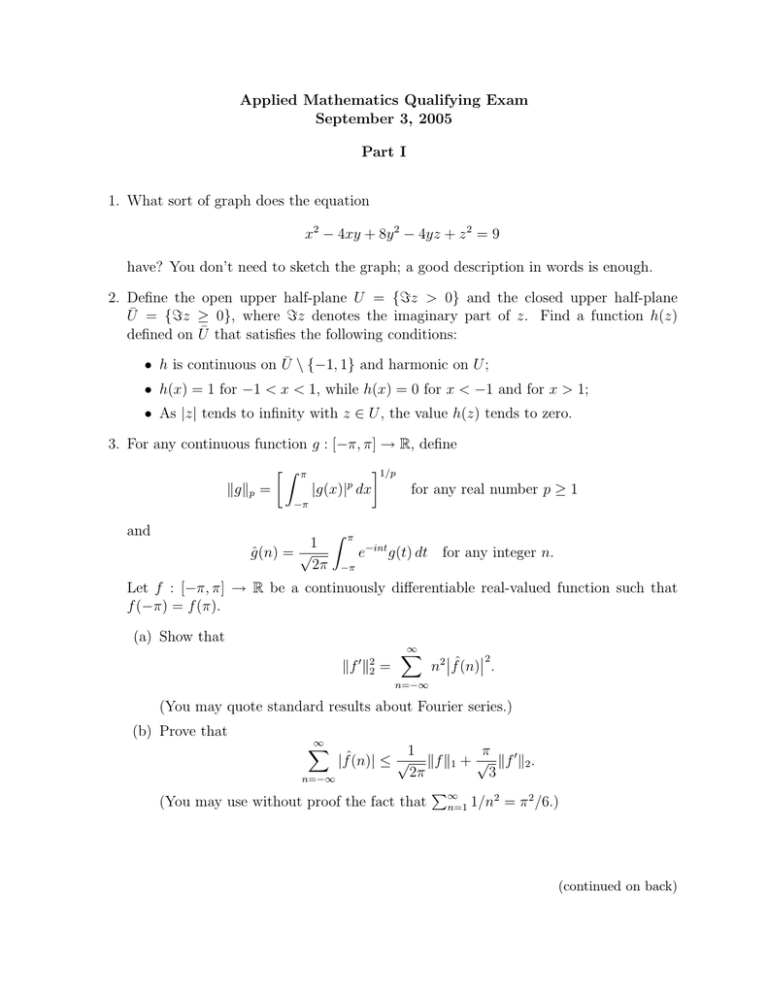
Applied Mathematics Qualifying Exam
September 3, 2005
Part I
1. What sort of graph does the equation
x2 − 4xy + 8y 2 − 4yz + z 2 = 9
have? You don’t need to sketch the graph; a good description in words is enough.
2. Define the open upper half-plane U = {=z > 0} and the closed upper half-plane
Ū = {=z ≥ 0}, where =z denotes the imaginary part of z. Find a function h(z)
defined on Ū that satisfies the following conditions:
• h is continuous on Ū \ {−1, 1} and harmonic on U ;
• h(x) = 1 for −1 < x < 1, while h(x) = 0 for x < −1 and for x > 1;
• As |z| tends to infinity with z ∈ U , the value h(z) tends to zero.
3. For any continuous function g : [−π, π] → R, define
Z
1/p
π
p
|g(x)| dx
kgkp =
for any real number p ≥ 1
−π
and
1
ĝ(n) = √
2π
Z
π
e−int g(t) dt for any integer n.
−π
Let f : [−π, π] → R be a continuously differentiable real-valued function such that
f (−π) = f (π).
(a) Show that
kf 0 k22
=
∞
X
2
n2 fˆ(n) .
n=−∞
(You may quote standard results about Fourier series.)
(b) Prove that
∞
X
1
π
|fˆ(n)| ≤ √ kf k1 + √ kf 0 k2 .
2π
3
n=−∞
P
2
2
(You may use without proof the fact that ∞
n=1 1/n = π /6.)
(continued on back)
4. The motion x = x(t) of a particle in a symmetric double-well potential is modeled by
the following ODE in dimensionless form:
x00 + ω 2 (x − x3 ) = 0.
Here ω > 0 is constant.
(a) Find and classify the type of each equilibrium point.
(b) Plot the phase-plane x0 versus x for this conservative system.
(c) Let the initial conditions be x(0) = 0 and x0 (0) = x0 . For what values of x0 does
a periodic solution exist?
0 1
1 1
5. Define A =
and B =
.
−1 2
0 1
(a) Show that A is similar to B.
(b) Verify that
tB
e
t
e tet
.
=
0 et
(c) Solve the system of differential equations
dx(t)
= Ax(t),
dt
3
x(0) =
.
2
6. Using the calculus of residues (contour integration), evaluate the integral
Z
0
∞
x1/3
dx.
1 + x2
Applied Mathematics Qualifying Exam
September 3, 2005
Part II
1. Let F be the vector field defined by
F(x, y, z) = (x2 + x)i − (3xz − y)j + (4z + 1)k.
Let S denote the surface of the sphere given by the equation x2 + y 2 + z 2 = 4.
(a) Calculate the flux of the vector field F outwards through S.
(b) Let S1 denote the part of S that lies above the xy-plane. Calculate the flux of F
upwards through S1 .
2. Let a > 0, D, α, and u1 > u0 be constants. Suppose that a ball of radius a > 0
is initially heated to a uniform temperature u1 and then proceeds to cool off due to
Newtonian cooling on the boundary sphere. Assume that the temperature u(r, t) is
radially symmetric. An appropriate model is a function u satisfying:
• ut = D(urr + 2r ur ) for 0 ≤ r ≤ a and t ≥ 0;
• −Dur = α(u − u0 ) on r = a;
• u is bounded as r → 0;
• u(r, 0) = u1 for 0 ≤ r ≤ a.
(a) What are the physical dimensions of D and α? What is the steady-state solution?
(The tranformation u = v/r is helpful here.)
(b) Show that the eigenvalue relation has the form tan z = z/(1−β) for some constant
β. Calculate β explicitly, show that β is dimensionless, and graph the eigenvalue
relation. Express the solution as an eigenfunction expansion.
3. Let I be the m × m identity matrix and J the m × m matrix with 1 in every entry.
(a) Prove that det(qI + rJ) = q m−1 (mr + q) for all real numbers q and r.
(b) Assume that q > 0 and r > 0. If A is an m × n matrix with AAT = qI + rJ, show
that m ≤ n.
(continued on back)
4. Let a1 , . . . , an ∈ R. Show that for an appropriate choice of branch, the transformation
z 7→
!1/n
n
Y
(z − ai )
i=1
maps the upper half plane into itself. Describe the image of the real axis.
5. Show that
21−p ≤
xp + y p
≤1
(x + y)p
for any x > 0, y > 0, p ≥ 1.
6. The displacements y1 (t) and y2 (t) for a coupled mass-spring system subject to an
external forcing f (t) satisfy the ODE system
m1 y100 = −k1 y1 + k2 (y2 − y1 )
m2 y200 = −k2 (y2 − y1 ) + f (t) .
(a) Write this system in the form y 00 = Ay + g for some matrix A and some vectors
y and g.
(b) If m1 = m2 = 1, k1 = 5, k2 = 6, and f (t) = 0, find the general solution to this
system by first looking for a solution√of the form y = veiω0 t for some unknown
vector v and frequency ω0 . (Here i = −1.)
(c) Now let f (t) = sin(ωt). Find a particular solution for this system of the form
y(t) = r sin(ωt), where r is a vector independent of t but dependent on ω that
is to be found. Give a rough plot of |r| versus ω 2 . For what values of ω will
resonance occur?

